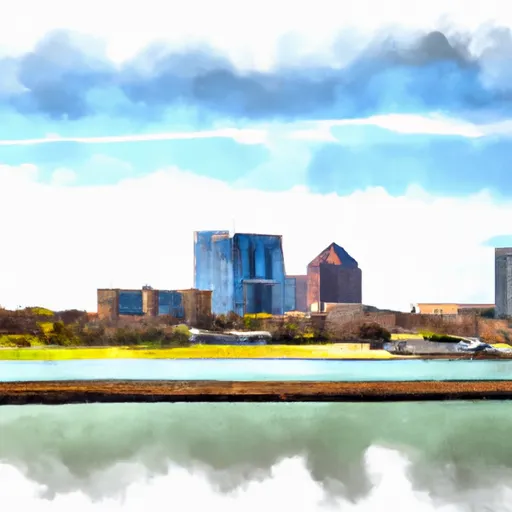-
 Snoflo Premium
Snoflo Premium
Get unlimited access to all our content
With no Ad interruptions! - Start Your Free Trial Login with existing account
Rockwall
Eden Index
Climate
9.7
•
Recreation
3.5
•
Community
5.3
•
Safeguard
6.4/10

Rockwall, Texas is a vibrant city located in the northeastern part of the state, known for its picturesque landscapes and outdoor activities. The climate in Rockwall is classified as humid subtropical, characterized by hot summers and mild winters. Summers are typically hot and humid with temperatures often rising above 90°F, while winters are mild with temperatures rarely dropping below freezing.
Rockwall is blessed with abundant hydrological resources, including its namesake, the Rockwall Lake. The lake offers various recreational opportunities such as fishing, boating, and water sports. Additionally, the city is home to several other lakes and reservoirs, providing additional options for outdoor enthusiasts.
Outdoor recreation opportunities in Rockwall extend beyond its water bodies. The city boasts numerous parks, hiking trails, and golf courses, allowing residents and visitors to enjoy activities like picnicking, walking, jogging, and playing sports. The city also hosts regular events and festivals throughout the year, providing further entertainment for its residents.
In conclusion, Rockwall, Texas, offers a desirable climate, diverse hydrological constituents, and a variety of outdoor recreation opportunities, making it an appealing destination for nature lovers and adventure seekers.
What is the Eden Index?
The Snoflo Eden Index serves as a comprehensive rating system for regions, evaluating their desirability through a holistic assessment of climate health, outdoor recreation opportunities, and natural disaster risk, acknowledging the profound impact of these factors on livability and well-being.
Climate Health Indicator (CHI): 9.7
Rockwall receives approximately
1041mm of rain per year,
with humidity levels near 78%
and air temperatures averaging around
19°C.
Rockwall has a plant hardyness factor of
8, meaning
plants and agriculture in this region tend to thrive here all year round.
By considering the ideal temperature range, reliable water supplies, clean air, and stable seasonal rain or snowpacks, the Climate Health Indicator (CHI) underscores the significance of a healthy climate as the foundation for quality living.
A healthy climate is paramount for ensuring a high quality of life and livability in a region, fostering both physical well-being and environmental harmony. This can be characterized by ideal temperatures, reliable access to water supplies, clean air, and consistent seasonal rain or snowpacks.
Weather Forecast
Streamflow Conditions
Upper Trinity
Area Rivers
Upper Trinity
Snowpack Depths
Upper Trinity
Reservoir Storage Capacity
Upper Trinity
Groundwater Levels
Recreational Opportunity Index (ROI): 3.5
The Recreational Opportunity Index (ROI) recognizes the value of outdoor recreational options, such as parks, hiking trails, camping sites, and fishing spots, while acknowledging that climate plays a pivotal role in ensuring the comfort and consistency of these experiences.
Access to outdoor recreational opportunities, encompassing activities such as parks, hiking, camping, and fishing, is crucial for overall well-being, and the climate plays a pivotal role in enabling and enhancing these experiences, ensuring that individuals can engage in nature-based activities comfortably and consistently.
Camping Areas
| Campground | Campsites | Reservations | Toilets | Showers | Elevation |
|---|---|---|---|---|---|
| Public Use Area 3 - Groesbeck | None | 382 ft | |||
| Public Use Area 2 - Groesbeck | None | 421 ft | |||
| Platter Flats - Lake Texoma | None | 646 ft | |||
| Erwin Park - McKinney | None | 637 ft | |||
| Lake Mexia Rec Area | 22 | 471 ft | |||
| Fort Parker State Park | 25 | 449 ft | |||
| East Burns Run - Lake Texoma | None | 661 ft | |||
| Public Use Area 5 - Thornton | None | 369 ft | |||
| Preston Bend - Lake Texoma | None | 676 ft | |||
| Dam Site | None | 560 ft |
Catastrophe Safeguard Index (CSI):
The Catastrophe Safeguard Index (CSI) recognizes that natural disaster risk, encompassing floods, fires, hurricanes, and tornadoes, can drastically affect safety and the overall appeal of an area.
The level of natural disaster risk in a region significantly affects safety and the overall livability, with climate change amplifying these risks by potentially increasing the frequency and intensity of events like floods, fires, hurricanes, and tornadoes, thereby posing substantial challenges to community resilience and well-being.
Community Resilience Indicator (CRI): 5.3
The Community Resilience Indicator (CRI) recognizes that education, healthcare, and socioeconomics are crucial to the well-being of a region. The CRI acknowledges the profound impact of these elements on residents' overall quality of life. By evaluating educational resources, healthcare accessibility, and economic inclusivity, the index captures the essential aspects that contribute to a thriving community, fostering resident satisfaction, equity, and social cohesion.

